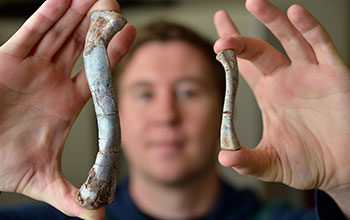Multimedia Gallery
Fossils provide insight into how dinosaurs grew (Image 3)
Christopher Griffin, a geosciences master’s student at Virginia Tech College of Science, holds two differently sized upper leg bones, one from a large specimen (right hand), the other from a smaller specimen (left hand), of the species Asilisaurus kongwe. The animals are believed to have lived as far back as 240 million years ago. [Image 3 of 4 related images. See Image 4.]
More about this image
Paleontologists at Virginia Tech (VT) have found that muscle-scarred fossil leg bones of one of the closest cousins of dinosaurs that lived approximately 240 million years ago can shine new light on a large unknown: How early dinosaurs grew from hatchlings to adults. Their research shows that dinosaurs and their close relatives had much more variation in growth patterns then ever expected, and this variation does not appear to be related to differences between males and females.
Christopher Griffin, a geosciences master’s student at VT, focused his study on muscle scars etched into the fossil bones of Asilisaurus kongwe, a dinosaur cousin that lived roughly 10 million years earlier than the oldest known dinosaurs.
In studying the anatomy and bone tissue of a large number of Asilisaurus specimens that were found in Tanzania during a 2007 expedition, and how each changed during growth, Griffin and study co-author Sterling Nesbitt, as assistant professor at VT, found the although these individual animals lived in roughly the same location at the same time, they grew differently from each other. Griffin compared these findings to a modern family, with siblings and cousins differing in height and body mass.
Griffin and Nesbitt also studied bone scars on Asilisaurus leg bones, focusing on spots where muscles and tendons attach to bone. The more mature an individual was at death, the larger its bone scars appeared. As with any animal or person, they may go from possessing one scar to numerous scars throughout their lifetime, with scars appearing in a particular order as the age of the individual increases.
Findings show that except for the smallest and largest individuals--the least and most mature--size is a poor predictor of skeletal maturity in Asilisaurus, and therefore likely in early dinosaurs as well. Further, similar differences in early dinosaurs had been thought to represent a difference in sex, with more "mature" individuals representing one sex and more "immature" individuals representing another.
"Our study includes more individuals and more bone scars, and with this increase in sample size we found that individuals fall on a trajectory that is more similar to maturity difference than sexual difference," says Griffin. "This suggests that similar variation in bone scars in early dinosaurs is variation in growth, not male and female difference. Because this variation appears to be widespread among early dinosaurs and their closest relatives, it is likely that high variation in growth between individuals characterized the most recent common ancestor of Asilisaurus and all dinosaurs."
The study was funded in part by the National Science Foundation’s Research Experience for Undergraduates program (grant DBI 11-56594).
To learn more about this research, see the VT news story 240-million-year-old fossils provide new insight into how dinosaurs grew from hatchling to adult. (Date image taken: March 2016; date originally posted to NSF Multimedia Gallery: June 7, 2017)
Credit: Jim Stroup, Virginia Tech; illustration by Andrey Atuchin
See other images like this on your iPhone or iPad download NSF Science Zone on the Apple App Store.
Images and other media in the National Science Foundation Multimedia Gallery are available for use in print and electronic material by NSF employees, members of the media, university staff, teachers and the general public. All media in the gallery are intended for personal, educational and nonprofit/non-commercial use only.
Images credited to the National Science Foundation, a federal agency, are in the public domain. The images were created by employees of the United States Government as part of their official duties or prepared by contractors as "works for hire" for NSF. You may freely use NSF-credited images and, at your discretion, credit NSF with a "Courtesy: National Science Foundation" notation.
Additional information about general usage can be found in Conditions.
Also Available:
Download the high-resolution JPG version of the image. (6.9 MB)
Use your mouse to right-click (Mac users may need to Ctrl-click) the link above and choose the option that will save the file or target to your computer.

